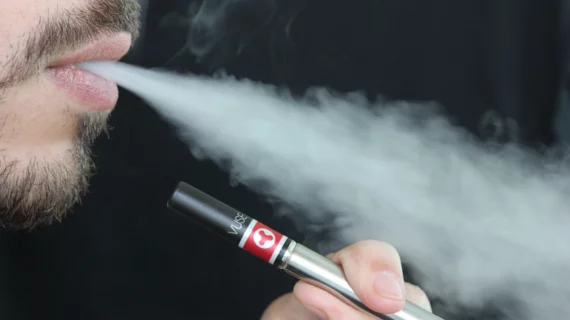Alternate addiction: 1.9 million US e-cig users have never smoked cigarettes
E-cigarettes have been touted as a way to help people stop using combustible cigarettes, but a new analysis in the Annals of Internal Medicine estimates 1.9 million American adults who vape have never smoked tobacco cigarettes.
“E-cigarettes remain the most controversial smoking cessation intervention, and public health authorities are concerned that e-cigarette uptake among tobacco-naive people might outstrip the potential utility of e-cigarettes as quit devices,” wrote lead author Michael J. Blaha, MD, MPH, and colleagues with the American Heart Association Tobacco Regulation and Addiction Center. “Indeed, the newest generations of e-cigarettes (including JUUL) are designed and marketed to appeal to non-combustible cigarette smokers.”
Using the Behavioral Risk Factor Surveillance System 2016, the researchers pulled responses from more than 260,000 adults who reported having smoked fewer than 100 cigarettes in their lifetime, classifying that group as never smokers. But 1.4 percent of those respondents reported smoking e-cigarettes daily or occasionally, translating to approximately 1.9 million adults nationwide.
Blaha et al. reported adults aged 18 to 24 accounted for about 60 percent of these sole e-cig users, or 1.2 million people. In addition, they found that men comprised 65.5 percent of the sole e-cigarette user group, and state-level vaping prevalence varied from 2.1 percent in Michigan to 0.4 percent in Alaska.
“The notable magnitude of the population of sole e-cigarette users highlights the potential need to regulate sales and marketing of e-cigarettes to protect vulnerable populations, including young persons who have never smoked combustible cigarettes,” Blaha and colleagues wrote.
Another finding from the survey was that e-cigarette users were more likely to self-report poor mental and physical health, and were also more likely to engage in other risky health behaviors such as binge drinking, marijuana use and risky sexual activities.
“The behavior characterization of sole e-cigarette users may help to target those who are at higher risk for initiation of e-cigarette use and may facilitate discussions about healthy lifestyles,” the researchers wrote.
The authors acknowledged their data was unable to shed light on whether e-cigarette users may have smoked combustible cigarettes otherwise, or whether e-cig use served as a gateway habit and put that population at higher risk for later use of tobacco cigarettes.
Writing in a related editorial, Anne N. Thorndike, MD, MPH, suggested a third scenario as being more likely for young users: “Teenagers who vape may never switch to smoking but will become nicotine-dependent adults who vape.”
“With novel vaping technologies that deliver high doses of nicotine efficiently and cleanly, the gateway theory may be outdated,” wrote Thorndike, with Massachusetts General Hospital and Harvard Medical School in Boston. “A recent online poll revealed that two thirds of teenagers who vaped believed that vaping could be part of a ‘healthy life.’ Youths who become nicotine dependent using a sleek device that delivers high-dose nicotine have no need or desire to switch to dirty, unhealthy combustible cigarettes.”
Recognizing that e-cigarettes have become “an epidemic” among teens, FDA Commissioner Scott Gottlieb, MD, announced a crackdown on the industry in September. The FDA subsequently conducted a surprise inspection at the offices of JUUL Labs, which controls 72 percent of the e-cig market, seizing more than 1,000 pages of documents related to the company’s marketing and sales practices.
In a different viewpoint published in the Annals of Internal Medicine, Steven A. Schroeder, MD, questioned how tightly the FDA should regulate the industry. He agreed that youth vaping habits are a concern, but isn’t convinced that problem is greater than the issue of adults who need help quitting traditional cigarettes.
“In his announcement, Commissioner Gottlieb acknowledged the potential tradeoff resulting from banning flavors, which might deter youth use of e-cigarettes but also discourage adult smoking cessation,” wrote Schroeder, with the University of California, San Francisco. “In contemplating this tradeoff, he needs to consider that 500,000 adults will die this year from continued smoking, whereas the long-term adverse consequences of vaping on youths are unknown.”
Schroeder pointed out reports from expert groups in England and the U.S. “have estimated that the risk of e-cigarettes is much lower than that of combustible tobacco, but not negligible.”
“In the United States, however, public perceptions of the toxicity of nicotine are much higher than warranted, possibly inspired by sensationalized reporting about e-cigarette use,” Schroeder wrote.
But even if health risks associated with vaping are unproven or minimal, Thorndike said nicotine addiction still affects people personally—and its economic and societal costs are still relevant.
“Nicotine-dependent users may need to take regular vaping breaks that interfere with work or other activities or may experience prolonged periods without vaping that cause psychological distress due to withdrawal,” she wrote. “The economic cost of a regular JUUL habit is similar to that of a 1-pack-per-day smoking habit.”

